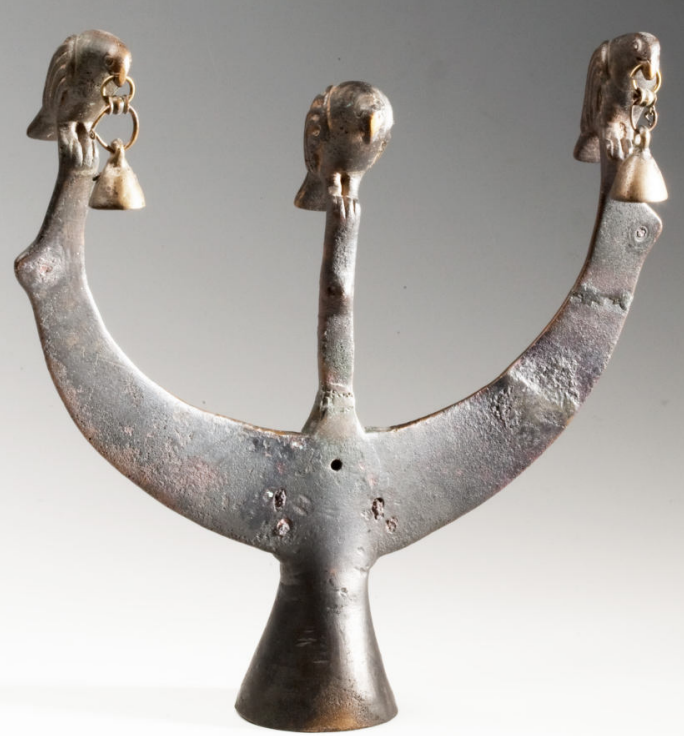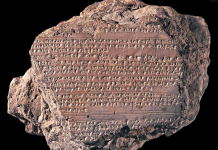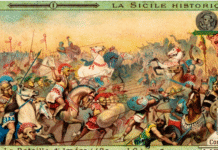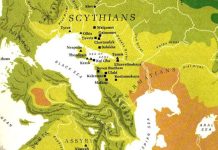Scythian bronze Trident Pole-top with sculptured figures of birds with bells in the beaks on its tips dating to the 4th c. B.C. was discovered more than a century ago in Alexandropol Kurgan situated in Dnipro region, was the largest of the Royal Scythian Barrows in Ukraine. (Read more about Alexandropol Kurgan). Why trident anyway? American classical philologist and linguist Emory Bair Lease wrote in his 1919 article ‘The Number Three, Mysterious, Mystic, Magic‘ published by The University of Chicago Press: “From time to time in the history of the world various numbers, chiefly those from 1 to 12, have been regarded as possessing a mystical significance, but there can be no doubt that in the extent, variety, and frequency of its use, the number 3 far surpasses all the rest… The number 3 plays a prominent part in ritualistic observances, as when the priest, as an act of ceremonial purification, thrice sprinkles the mourners with pure water (Verg. Aen. vi. 229), and when the pious Aeneas thrice invokes the departed spirit of his friend, Deiphobus (ibid., 506). Similarly, the enchantress, Medea, “thrice purifies Jason with fire, thrice with water, and thrice with sulphur” (Ovid Metamorph. viii. 261)…
In charms also the number 3 was considered to be of great potency. This particular variety may therefore be denominated the Therapeutic 3. The field is so large that a few illustrations will have to suffice. It is interesting to note that no less a person than the great Caesar, ” as soon as he had taken his seat in the carriage, was accustomed to repeat a certain formula 3 times in order to secure safety in his journey” (Plin. Nat. Hist. xxviii. 21). So also the enchantress, Medea, indulges in a 3-fold incantation in order to put to sleep the dragon of the 3-forked tongue, and, as a preliminary step to invoking divine aid, “3 nights before the full moon thrice turns about and thrice sprinkles water on her head before crying out a 3-fold supplication to Hecate of the 3 forms (Ovid Metamorph. vii. 153; 190)…
These uses of the number 3 can be more easily understood and appreciated when studied in the light of the usage of other nations. Furthermore, a similarity in usage shows the homogeneity of the human mind. As there were trinities in the classical world, so also we find them in India, where the great Hindu trinity, the Tri-murti (Brahma, Siva, Vishnu), three deities worshiped collectively, is best known. Each god had 3 incarnations, those of Vishnu being connected with the Deluge (Max Mueller, India, p. 144), and “Vish-nu’s Three Strides” covering the heavens was a tale oft told. It is interesting also to note that Siva’s emblem, like Poseidon’s, was a Trident, and that the Hindu priest, as the last step to render the victim sacred, thrice turns round it with a lighted torch.
But Buddhism went still farther: “out of the five last Buddhas of the earlier teaching, there grew up five mystic trinities” (Ency. Brit.L, XVI, 97).
There was also a trinity of Vedic gods (Agni, Indra, Surya). And Babylon had two divine triads, Egypt many, the chief being that composed of Osiris, Isis, and Horus…
The triadic system was also a prominent feature in the religion of the Chaldeans, Phrygians, and Scythians. According to Herodotus (viii. 137) “the first man of the Scythians was a son of Zeus and had 3 sons.”
In the realm of folklore, the number 3 was particularly prolific, manifesting itself in the triple repetition of the same act. The illustrations from all lands are so numerous that only an abbreviated selection is possible…
That the number 3 has often a meaning far different from its numerical value has been commented on by the ancients, as, e.g., Aristotle (De Caelo, i. 1): “The triad is the number of the complete whole, inasmuch as it contains a beginning, a middle, and an end. Nature herself has provided us with this number for use in the holy service of the gods.”
The three-in-one idea was given its simplest expression by the Pythagoreans, who adopted the triangle,’ “the most perfect geometrical figure, inasmuch as it was the first form complete in itself.” It was only natural therefore that the number 3, being graphically represented by the Greek mathematicians by a triangle (a figure composed of 3 lines, 3 angles, its angles measured in 3 ways, and only 3), which was regarded as perfect, should on account of this representation also come to be regarded as the perfect number There were also other considerations that tended to deepen this conviction, the fact that 3 is the sum of the mystic 1 and of the mystic 2, that is, could not be divided (cf. Servius’ note p. 69 supra), and was therefore like the gods, immortal, perfect, sacred.
Scythologists think that Alexandropol Trident with birds on it is a representation of the Scythian World Tree. Can it be that the Trident of Ukraine Coat of Arms derives from the Trident of the Scythians?
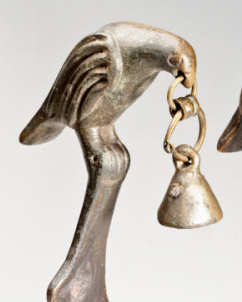
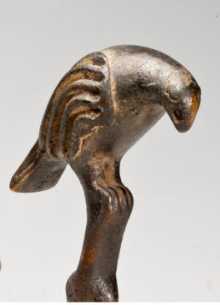
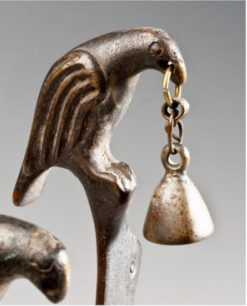
The “Royal Scythia, Greece, Kyiv Rus” book explains the connection. The “Cradle of Civilizations” addresses the question as well but also takes a closer look at such characters as Medea and Pythagoras.



